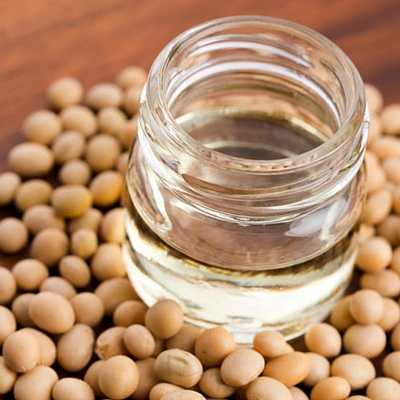Soybean Oil
Also known as Vegetable Oil
What is Soybean Oil?
Soybean oil is the world’s second largest source of vegetable oil and is around 90 percent of all U.S. oilseed production. Commonly known as “vegetable oil,” it is popular for its high smoke point and low cost.
Soybean oil has no cholesterol or saturated fat, but it is rich in polyunsaturated fatty acids (PUFAs).1 Soybean oil is used to make the popular emulsifier lecithin. Fully hydrogenated soybean oil is in high demanded as well, as a hard oil with no trans fat.2
Origin
The first record of soybean oil dates back to the 11th century in China as one of five main plant foods. It began being exported as a fertilizer. Soybeans spread to Europe in the 1700s and the first U.S. crop surfaced in 1829. It was used for soy sauce, by Civil War soldiers to substitute scarce coffee, and by farmers as a forage crop.
It wasn’t until George Washington Carver began studying the soybean that it was used for it’s valuable protein and oil. During WWII, the U.S. turned to soybean for their oil supply, as exported sources were cut. It grew in popularity from there, helped by it’s low cost, and has become one of the most used oil supplies in U.S. baking.
Commercial Production
Although soybean oil can be produced mechanically with hydraulic presses, the process is expensive with low returns of the product. The most common commercial production today is solvent extraction. Soybeans are cleaned, dried, and then dehulled before being immersed in a solvent–usually hexane, which is then evaporated.
Soybean oil commonly comes in partially or fully hydrogenated form, to increase shelf life or lower its high levels of linoleic acid from 8 percent to 3 percent. This also makes it more stable as a frying oil.2
In efforts to eliminate trans fat in foods, soybean growers have been reducing the plant’s saturated fats, to create a higher oleic content than linoleic content in the bean itself.3
Application
Soybean oil has a clean natural taste and enhances natural flavors in products. Soybean oil mixes well with other fats and oils, making it a good ingredient for baked goods. Soybean oil is available with OSI stability levels from 7 to 60 hours. It also works well as a an emulsifying agent, compared to other vegetable oils.
Fully hydrogenated soybean oil has no trans fat, but instead converts it 100 percent to stearic acid. It is extremely popular as a hard fat for bakery shortenings.4
Research has found the use of stearidonic acid soybean oil improved functional and sensory attributes in bagels, breakfast bars, pastries, cookies, icings, and chocolate coatings.5
FDA Regulations
Hydrogenated soybean oil is deemed GRAS by the FDA. Trans fat is being transitioned out of baked and packaged goods by the FDA, meaning partially-hydrogenated soybean oil will not be allowed. Soybeans must be declared as an ingredient in shortenings, and if it is hydrogenated or not.
References
- Deol, Poonamjot, Jane R. Evans, Joseph Dhahbi, Karthikeyani Chellappa, Diana S. Han, Stephen Spindler, and Frances M. Sladek. “Soybean Oil Is More Obesogenic and Diabetogenic than Coconut Oil and Fructose in Mouse: Potential Role for the Liver.” PLOS ONE PLoS ONE 10.7 (2015): n. pag. Web.
- List, G. R., M. Jackson, F. Eller, and R. O. Adlof. “Low Trans Spread and Shortening Oils via Hydrogenation of Soybean Oil.” Journal of the American Oil Chemists’ Society J Amer Oil Chem Soc 84.6 (2007): 609-12. Web.
- Ribeiro, Ana Paula B., Renato Grimaldi, Luiz A. Gioielli, and Lireny A.g. Gonçalves. “Zero Trans Fats from Soybean Oil and Fully Hydrogenated Soybean Oil: Physico-chemical Properties and Food Applications.” Food Research International 42.3 (2009): 401-10. Web.
- Shahidi, Fereidoon. Nutraceutical and Specialty Lipids and Their Co-products. Boca Raton: CRC/Taylor & Francis, 2006. Print.
- Whittinghill, Jane, and David Welsby. “Use of SDA Soybean Oil in Bakery Applications.” Lipid Technology 22.9 (2010): 203-05. Web.


